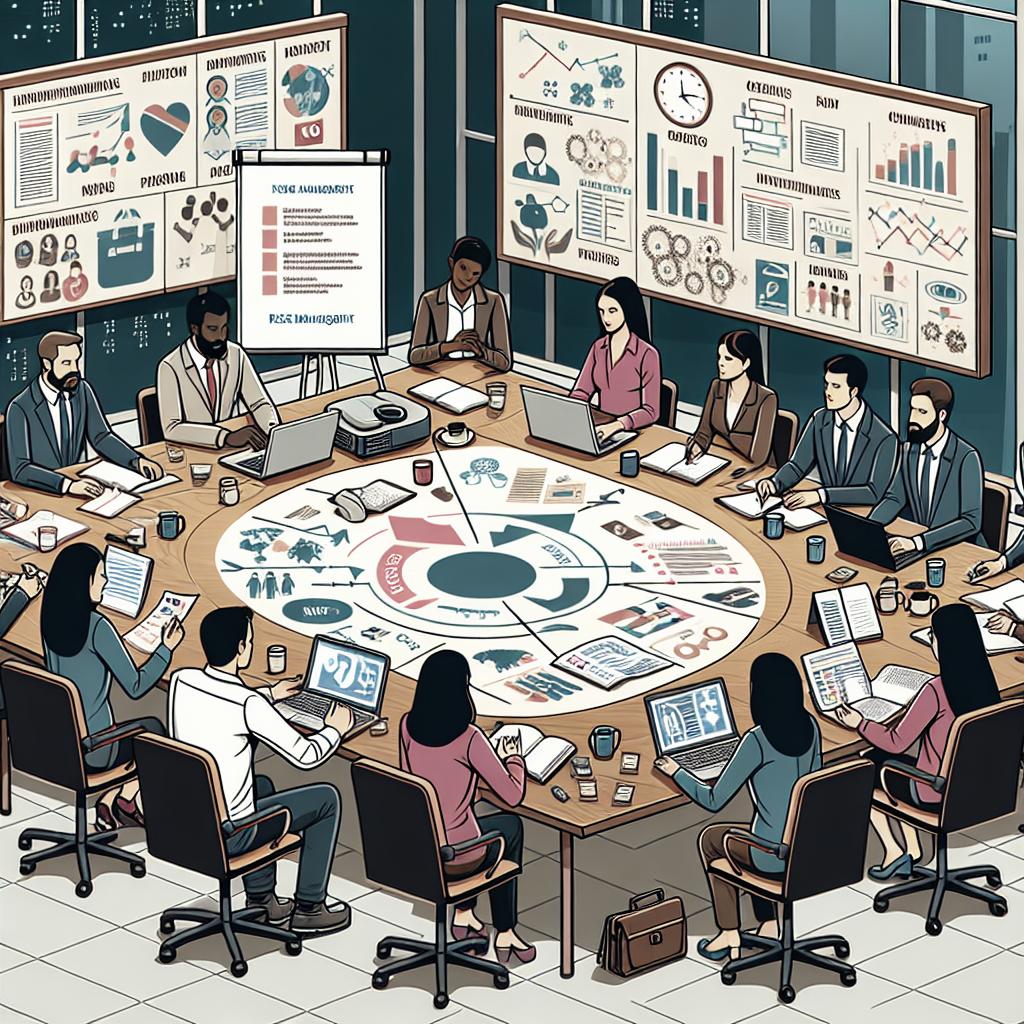“`html
How to Develop a Comprehensive Risk Management Plan for NGOs
Creating a comprehensive risk management plan is pivotal for non-governmental organizations (NGOs) striving to achieve their missions amidst various uncertainties. With risks ranging from financial challenges, operational disruptions, to reputation damage, NGOs must adopt effective strategies tailored to their unique needs. This guide explores essential steps and techniques to craft a robust risk management plan, highlighting the importance of good planning and collaboration with third-party vendors. Additionally, it provides insights into risk identification, analysis, evaluation, addressing, and monitoring. Sample checklists and essential liability information are included to equip NGOs with practical risk management tools, ensuring resilience and sustainability in their valuable work.
Risk Management Plan: Overview
A risk management plan is a strategic approach to identify, assess, and address potential risks that could hinder an organization’s goals and objectives. For NGOs, a detailed plan is crucial to ensure the continuation of their projects and services, often in unpredictable environments. This plan provides a structured framework for decision-making and resource allocation, emphasizing the proactive handling of risks.
The complexity of risk management requires an in-depth understanding of both external and internal factors that can affect an NGO’s function. It combines strategic thinking with actionable techniques to add layers of protection and preparedness. By clearly defining roles and responsibilities, organizations can efficiently tackle challenges, mitigate adverse impacts, and enhance their operational resilience.
Good Risk Management Plans Save Projects
Effective risk management plans are lifesavers for nonprofit projects. By predicting potential pitfalls, these plans facilitate timely interventions that can prevent a project from failing. Comprehensive planning helps allocate resources efficiently, preserving time, funds, and effort that could be otherwise wasted on unforeseen setbacks.
Furthermore, well-constructed risk management frameworks increase stakeholder confidence. Donors and partners are more likely to support NGOs that exhibit resilience and foresight. This, in turn, facilitates sustainable project growth and continuity, reinforcing an NGO’s ability to deliver its mission and enhance its impact on the communities it serves.
Reduce Liability with Third-Party Vendors
Collaborating with third-party vendors introduces additional layers of risk, mainly around compliance, security, and financial stability. To minimize potential liabilities, NGOs should vet vendors thoroughly before engagement, ensuring their values and operating procedures align with the organization’s standards.
Creating clear contractual agreements that outline expectations, obligations, and resolution procedures is crucial. Implementing regular reviews and audits of vendor performance ensures ongoing compliance and risk mitigation, fostering a safe and productive partnership that benefits all involved parties.
Step 1: Identify
Techniques for Gathering Information
The initial step in risk management is identifying potential risks. Techniques like assumption analysis help detect areas where uncertainties may cloud judgment, while brainstorming sessions foster a collaborative environment for risk idea generation. Gathering diverse perspectives highlights varied potential risks.
Assumption Analysis
Assumption analysis scrutinizes underlying assumptions that could affect an NGO’s operations. By challenging these assumptions, organizations can identify gaps and areas for improvement, paving the way for a more robust risk management strategy.
Brainstorming
Brainstorming sessions are an effective way to pool ideas and draw upon collective knowledge within an organization. They facilitate creative thinking and encourage staff to voice potential threats that might not have been considered previously.
Event Inventories or Loss Data
Compiling event inventories or past loss data provides historical context, helping organizations understand previous risk occurrences and trends. This data-driven approach aids in predicting and preparing for future risks, enhancing strategic readiness.
Expert Judgment
Leveraging expert judgment involves consulting specialists or experienced personnel who offer valuable insights into potential risks based on their knowledge and expertise. This method is especially beneficial for identifying risks outside the usual scope of the organization’s internal knowledge base.
Facilitated Workshop
Facilitated workshops provide an organized setting for structured discussions around risk management. These sessions help harness a group’s collective expertise and encourage efficient dialogue, leading to enhanced identification and analysis of risks.
Interviews, Self-assessments, Questionnaires & Surveys
Utilizing interviews, self-assessments, questionnaires, and surveys facilitates a broad collection of information. These tools engage various stakeholders in identifying risks, resulting in a more comprehensive and inclusive risk management plan.
Step 2: Analyze
Techniques for Prioritizing Risk
Risk analysis involves prioritizing identified risks based on their likelihood and impact. This process helps in determining which risks should warrant immediate attention and resources. Techniques such as probability and impact matrices assist NGOs in quantifying risks, transforming risk management from a qualitative to a quantitative exercise.
Step 3: Evaluate
Techniques for Developing Your Risk Assessment Matrix
Developing a risk assessment matrix enables organizations to evaluate risks systematically. By plotting risks on a matrix based on their likelihood and impact, NGOs can visually prioritize management efforts, focusing on high likelihood-high impact risks that require immediate action.
This strategical evaluation helps in categorizing risks into manageable sections, facilitating focused discussions and targeted risk mitigation strategies, ultimately reducing the burden of ambiguity in complex risk scenarios.
Step 4: Address
Techniques for Risk Response Planning
Once risks are identified, prioritized, and evaluated, the next step is crafting a response plan. Techniques such as risk avoidance, reduction, sharing, and acceptance play crucial roles in addressing each risk effectively based on its severity and strategic implications.
Direct communication with stakeholders, emergency planning, and establishing backup resources are proactive measures that NGOs can incorporate to ensure they are well-prepared to respond to risks dynamically and effectively.
Step 5: Monitor/Review
Techniques for Continued Risk Management
Continuous monitoring and reviewing of risks ensure that an NGO’s risk management plan remains relevant and up-to-date. Regular audits, risk reviews, and adjustment of strategies based on evolving circumstances are key actions that reinforce effective risk management practices.
Implementing a feedback loop where the risks are reinvestigated can significantly enhance the agility of the NGO, ensuring swift adaptation to changes while maintaining resilience in a rapidly changing environment.
Sample Risk Management Checklists for Various Industries
Sample risk management checklists tailored to specific industries serve as valuable guides for NGOs operating in diverse sectors. These checklists cover common risk areas such as financial integrity, operational continuity, and ethical compliance, providing a comprehensive toolkit for risk identification and mitigation.
bcs
Building consulting services (bcs) can play a pivotal role in aiding NGOs in their risk management journeys. By offering expert guidance, training, and resources, these services empower NGOs to build stronger risk frameworks and foster a proactive, resilient organization culture.
Subscribe Now
Commercial General Liability Basics
Understanding the basics of commercial general liability is essential for NGOs to safeguard themselves against claims arising from everyday operations. Having a comprehensive liability policy is a critical component of any risk management plan, reducing financial exposure and providing peace of mind.
Subscribing to updates and insights from expert platforms keeps NGOs abreast of the latest trends, changes in liability laws, and best practices in risk management, enabling them to refine their strategies continually.
Summary of Main Points
| Step | Description |
|---|---|
| Identify | Utilize various techniques to uncover potential risks affecting the NGO’s operations. |
| Analyze | Prioritize risks based on likelihood and impact using quantitative metrics. |
| Evaluate | Develop and use a risk assessment matrix for systematic risk categorization and focus. |
| Address | Formulate risk response plans using techniques like avoidance, reduction, sharing, and acceptance. |
| Monitor/Review | Ensure the risk management plan is current with regular reviews and feedback adjustments. |
“`


